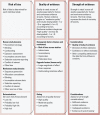The Navigation Guide - evidence-based medicine meets environmental health: integration of animal and human evidence for PFOA effects on fetal growth
- PMID: 24968389
- PMCID: PMC4181930
- DOI: 10.1289/ehp.1307923
The Navigation Guide - evidence-based medicine meets environmental health: integration of animal and human evidence for PFOA effects on fetal growth
Abstract
Background: The Navigation Guide is a novel systematic review method to synthesize scientific evidence and reach strength of evidence conclusions for environmental health decision making.
Objective: Our aim was to integrate scientific findings from human and nonhuman studies to determine the overall strength of evidence for the question "Does developmental exposure to perfluorooctanoic acid (PFOA) affect fetal growth in humans?"
Methods: We developed and applied prespecified criteria to systematically and transparently a) rate the quality of the scientific evidence as "high," "moderate," or "low"; b) rate the strength of the human and nonhuman evidence separately as "sufficient," "limited," "moderate," or "evidence of lack of toxicity"; and c) integrate the strength of the human and nonhuman evidence ratings into a strength of the evidence conclusion.
Results: We identified 18 epidemiology studies and 21 animal toxicology studies relevant to our study question. We rated both the human and nonhuman mammalian evidence as "moderate" quality and "sufficient" strength. Integration of these evidence ratings produced a final strength of evidence rating in which review authors concluded that PFOA is "known to be toxic" to human reproduction and development based on sufficient evidence of decreased fetal growth in both human and nonhuman mammalian species.
Conclusion: We concluded that developmental exposure to PFOA adversely affects human health based on sufficient evidence of decreased fetal growth in both human and nonhuman mammalian species. The results of this case study demonstrate the application of a systematic and transparent methodology, via the Navigation Guide, for reaching strength of evidence conclusions in environmental health.
Conflict of interest statement
The contents of this paper are solely the responsibility of the authors and do not necessarily represent the official views of the U.S. EPA. Further, the U.S. EPA does not endorse the purchase of any commercial products or services mentioned in the publication.
The authors declare they have no actual or potential competing financial interests.
Figures
Comment in
-
The Navigation Guide: systematic review for the environmental health sciences.Environ Health Perspect. 2014 Oct;122(10):A283. doi: 10.1289/ehp.122-A283. Environ Health Perspect. 2014. PMID: 25271710 Free PMC article. No abstract available.
-
Systematic reviews: perhaps "the answer to policy makers' prayers"?Environ Health Perspect. 2014 Oct;122(10):A262-3. doi: 10.1289/ehp.1408599. Environ Health Perspect. 2014. PMID: 25272205 Free PMC article. No abstract available.
References
-
- Antman EM, Lau J, Kupelnick B, Mosteller F, Chalmers TC. A comparison of results of meta-analyses of randomized control trials and recommendations of clinical experts. Treatments for myocardial infarction. JAMA. 1992;268:240–248. - PubMed
-
- Apelberg BJ, Goldman LR, Calafat AM, Herbstman JB, Kuklenyik Z, Heidler J, et al. Determinants of fetal exposure to polyfluoroalkyl compounds in Baltimore, Maryland. Environ Sci Technol. 2007;41:3891–3897. - PubMed
-
- Arbuckle TE, Kubwabo C, Walker M, Davis K, Lalonde K, Kosarac I, et al. Umbilical cord blood levels of perfluoroalkyl acids and polybrominated flame retardants. Int J Hyg Environ Health. 2012;216:184–194. - PubMed
-
- Balshem H, Helfand M, Schünemann HJ, Oxman AD, Kunz R, Brozek J, et al. GRADE guidelines: 3. Rating the quality of evidence. J Clin Epidemiol. 2011;64:401–406. - PubMed
Publication types
MeSH terms
Substances
Grants and funding
LinkOut - more resources
Full Text Sources
Other Literature Sources
Medical



